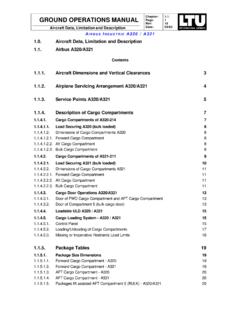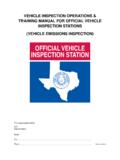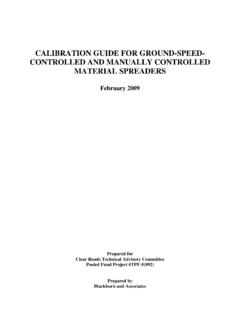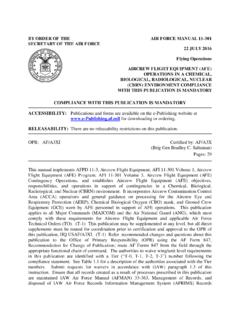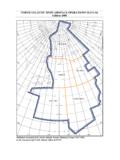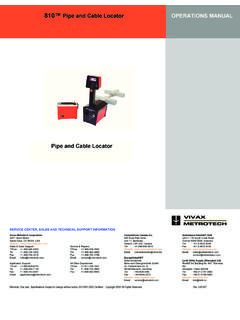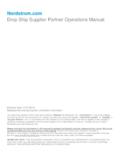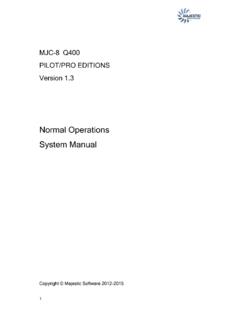Transcription of Part 10 Ground Operations - Helitavia
1 CAP 562 Civil Aircraft Airworthiness Information and Procedures part 10 Ground Operations Leaflet 10-1 Aircraft Handling 1 Introduction This Leaflet describes the Ground handling tasks which may be necessary during the normal day-to-day operation of an aircraft and details the procedures and precautions which are generally specified. These tasks vary considerably according to the size and type of aircraft concerned and the layout of the aircraft systems; this Leaflet should, therefore, be read in conjunction with the appropriate Maintenance Manual, where information relating to the particular aircraft will be found. 2 General The tasks which may be required to be carried out on an aircraft between flights, apart from routine maintenance, cover a variety of subjects and these are dealt with separately in paragraphs 3 to 8 of this Leaflet.
2 Special Ground equipment is often required to enable these tasks to be carried out satisfactorily; in the case of light- aircraft Operations this equipment may be of a very rudimentary nature, but when dealing with large transport aircraft more sophisticated equipment may be necessary. Preparations for the reception of an aircraft should be made in advance of its arrival. The positioning of aircraft in the reception area should be arranged so that access paths to the aircraft are available for all replenishing vehicles and for the loading and unloading of passengers or cargo as applicable. All equipment likely to be required for the servicing of an aircraft should be readily available and should be in a fully serviceable condition. When an aircraft has to be moved into a hangar in order to allow servicing Operations or maintenance to be carried out, it should be positioned so as to avoid obstructing access to other working space or necessitating disturbance before the work is complete.
3 Account should also be taken of the location of all necessary facilities such as weighing platforms, electric and pneumatic power sources, lighting and of the necessity for providing docks or platforms to enable the work to be carried out. 3 Towing It is often necessary to move an aircraft without starting the engines, in order to position it for servicing or to enable passengers or cargo to be loaded, if this operation is not carried out properly, severe damage can be caused to the aircraft. Should it be necessary to call upon the assistance of untrained or inexperienced persons to move the aircraft, the person taking charge should instruct them adequately before starting and ensure that they fully appreciate what they are required to do. Paragraphs and contain general information on the towing of aircraft and the precautions to be observed, but detailed information relating to the movement of a particular aircraft will be found in the manufacturer's Maintenance Manual for the aircraft concerned.
4 1 July 1990 part 10 Leaflet 10-1 Page 1. CAP 562 Civil Aircraft Airworthiness Information and Procedures Light Aircraft Great care should be exercised when manhandling light aircraft, particularly those manufactured from wood and fabric. On aircraft having a nose-wheel landing gear, a steering arm should be fitted to the nose wheel to guide the aircraft and force should be applied only to those parts of the structure which are designed to accept it. Force should not be applied to trailing edges of wings or control surfaces, to streamlined wires, or to areas which are marked to prohibit the application of force; an engine should always be regarded as 'live', therefore, a propeller should not be used to push or pull the aircraft. Generally it is better to push an aircraft backwards rather than forwards, since the leading edges of the wings and tailplane are stronger than the trailing edges, but the struts and undercarriages on some aircraft are suitable for pushing the aircraft forwards.
5 The flat of the hands should be used when pushing, so as to spread the load over the largest area, in addition when pushing on struts or undercarriages the force should be applied as near to the end fittings as possible. On aircraft with a steerable nose wheel connected to the rudder pedals, care must be taken not to exceed the turning limits, which are normally marked on the nose undercarriage leg. On this type of aircraft it is also important that the rudder controls are not locked during towing Operations . On aircraft which are fitted with a tail skid instead of a tail wheel, it is customary to raise the tail by lifting on the tailplane struts near to the fuselage fittings, so that the aircraft is balanced at the main wheels; the aircraft may then be pushed backwards as required. On some aircraft it may also be advisable to place the propeller in a horizontal position, to prevent it striking the Ground when the tail is lifted.
6 When towing a light aircraft by means of a tractor, the correct tow-bar should be connected between the towing attachment at the base of the nose undercarriage leg and the tractor; a person familiar with the aircraft brake system should be seated in the cockpit/cabin to operate the brakes in an emergency; the brakes should not normally be applied unless the aircraft is stationary. Once the tow-bar is connected, the brakes and, where fitted, the rudder lock, may be released and the aircraft towed forwards at a safe speed, depending on conditions in the vicinity. A close watch should be kept on the wing tips and tail, particularly in confined spaces, to ensure that they do not come into contact with other stationary or moving objects. Care should be taken when negotiating bends, to prevent the limits of nose-wheel movement being exceeded.
7 In circumstances where the Ground over which the aircraft has to be towed is either boggy or very uneven, the strain imposed on the nose undercarriage may be excessive and it may be necessary to tow the aircraft by means of bridles attached to each main undercarriage. If towing attachments are not provided on the main undercarriage legs, ropes should be passed carefully around the legs as near to the top as possible, avoiding fouling on adjacent pipes or structure. A separate tractor should be connected to each main undercarriage and steering should be carried out by means of a steering arm attached to the nose wheel rather than by differential movement of the tractors. Large Aircraft Large multi-engined aircraft are usually moved by towing with a tow-bar attached to the nose undercarriage leg, a special tug often being required to provide sufficient tractive effort.
8 The tow-bar is fitted with a shear-pin or bolt, which will shear at a 1 July 1990 part 10 Leaflet 10-1 Page 2. CAP 562 Civil Aircraft Airworthiness Information and Procedures predetermined load to prevent excessive force being applied to the nose undercarriage. The centre-of-gravity (C of G) of the aircraft must be determined before towing, to ensure that there is sufficient weight on the nose wheel. Adverse fuel distribution and the aircraft being in a non-standard condition ( with an engine removed), could affect the C of G position and a maximum aft limit is generally specified in the relevant Maintenance Manual. Ballast may sometimes be required to achieve a safe C of G. position, but the maximum towing weight must not be exceeded. Before towing is commenced the undercarriage Ground locks should be installed, the steering should, if applicable, be disconnected or disabled (usually by removing a steering disconnection pin, by inserting a lock-out pin, or by tripping the associated circuit breaker) and the nose undercarriage shock absorber should be checked for normal extension.
9 In addition, the brake pressure should be checked and, if necessary, built up to the minimum safe pressure (this is often accomplished by operation of an electrically-driven hydraulic pump, which must be used sparingly to prevent the motor overheating). If it is likely to be necessary to turn the nose wheel through a greater angle than the prescribed steering limits, the nose wheel is usually freed by removing the apex pin from the torque links, thus allowing the nose wheel complete freedom of movement, but particular attention must be paid to any limits imposed on aircraft having bogie undercarriages. When towing the aircraft, two qualified pilots or suitably trained and authorised members of the towing crew should be stationed in the cabin, to operate the brakes and any of the other aircraft systems which may be required and to keep a look-out and monitor progress.
10 These persons should be in telephonic communication with the outside Ground crew and with the tractor driver. Ground crew should be located at the wing tips and tail to guide the aircraft past any obstructions. One person should be in overall control of the operation. The aircraft brakes should be released before the tractor moves off and towing-speed should be kept down to a safe speed. The radii of turns should be kept as large as possible, to minimise tyre scrubbing and twisting loads on the main undercarriage legs. Care should be taken not to exceed any towing-force limits which may be specified in the relevant Maintenance Manual for various nose-wheel steering angles. Before stopping, the aircraft should be towed in a straight line for a short distance in order to remove any tyre stresses imposed by turning.


